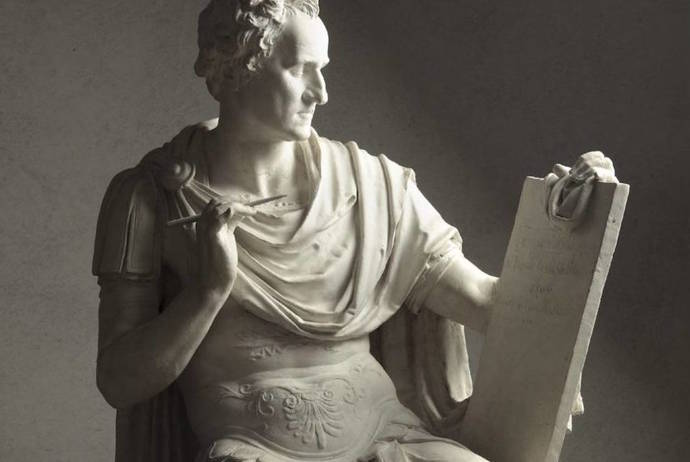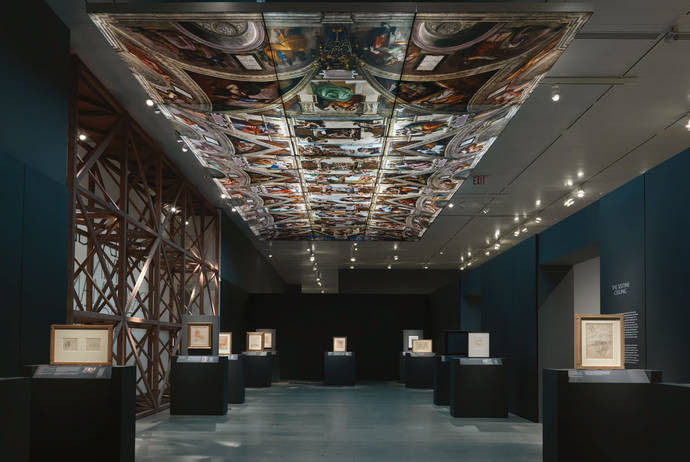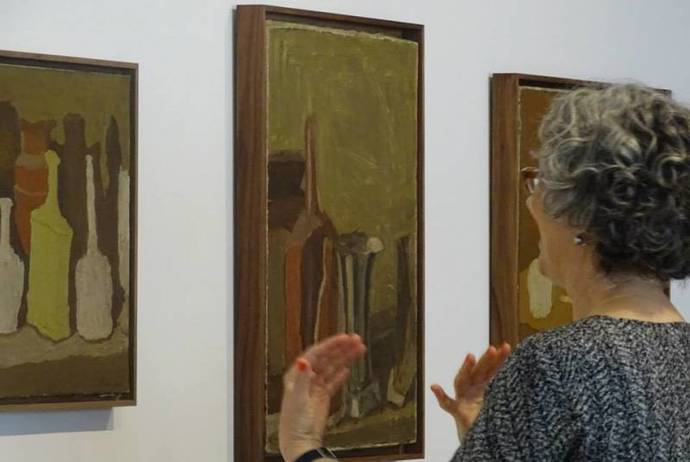I still remember when in 2007 the Solomon R. Guggenheim Museum presented Lucio Fontana: Venice/New York, the first major exhibition devoted to the artist in the United States since the museum’s 1977 retrospective.
It was a small exhibition that included 49 works and brought together two important series from 1961: Fontana’s Venice paintings and his New York series of metals, presented together for the first time.
It was organized under the auspices of the Milan-based Fondazione Lucio Fontana and was the most comprehensive presentation of Fontana’s work from that period. Critics back then wrote really nasty things about it, calling him a “decorator” rather than an artist.
How to Better Understand Fontana
The retrospective “Lucio Fontana: On the Threshold,” curated by Iria Candela and Emily Brown, on view at the Met Breuer through April 14, is much larger and stratified, though I find some of the choices, including the display, questionable. One of the intentions is to give the artist more recognition, as stated in articles by the New York Times and the Washington Post, but that’s not quite enough.
In my opinion, we will never understand this artist’s mission if we don’t contextualize it within his research and his vision. And I can say this because I was the co-curator with Matthew Gale of the exhibition about Fontana at the Tate Modern in London.
Therefore, I would like to put forward some preliminary notions about Italian Art History and about some of Fontana’s writings.
The Historical Context
In the first half of the 20th century, Italian artists began to investigate matter not as a static decorative element, but as a living, organic element, which, through its interactions, creates a “unicum” that is neither painting nor sculpture.
At the same time, in 1912 Picasso was conducting parallel studies in France, and had started introducing extra-pictorial materials in his paintings.
In Italy at that time, Futurism had just been founded. When talking about this avant-garde movement (do you remember the beautiful exhibition at Guggenheim a few years ago?), we must keep in mind a clear distinction between Futurism as an artistic phenomenon with political elements, and Futurism as a cultural and political movement whose theories changed the aesthetics of the 19th century. It was not a sudden change, but rather a gradual one born from a need within the movement itself, a clarification slowly brought to the consciousness of its protagonists.
In his essay "Art and Ideology", Karel Teige declared that "…before Futurism, Italy was oppressed by a heavy stagnation that had lasted for over half a century ... a careful reading of Futurist posters reveals a strong revolutionary core that proves fruitful for current poetry... It teaches us to measure the value of life by its intensity, to act to the utmost of our energy.”
The words of Albert Einstein, the father of relativism, are significant in this regard: "If what we contemplate and experience is shaped by the language of logic, we practice science, if it is mediated by forms whose links are inaccessible to conscious thought, even if intuitively recognizable as meaningful, we practice art."
This concept is totally aligned with two of the most “intuitive” statements by Lucio Fontana:
“There is an art that cannot be for everyone, and this is also true of other human creative manifestations. Humanity experiences them, and we owe our civilizations solely to this. The only freedom is intelligence.” (Lucio Fontana, Galleria del Naviglio, Milan, April 18, 1953)
And: “Really, I didn’t invent anything [...]. Futurists had already started to probe the limits of figuration and to consider art as a mysterious, philosophical fact, representing a new consciousness, not a figurative consciousness.”
Exploring the Possibilities of Spatial Environments
These ideas explain the new series of Spatial Environments that we can see today, the first one dating back to 1948-49 when it was displayed at the Galleria Il Milione in Milan. They are seen as: “Neither sculpture or painting, immediate art ... suggestions free from viewers in a spatial environment created by an artist, concept of art based on the evolution of the medium in art.”
1949 marked a turning point in Fontana’s career. During this year, he created the ‘Buchi’ (holes), his first series of paintings in which he punctured the canvas, and his first Spatial Environment, a combination of shapeless sculptures, fluorescent paintings, and black lights to be viewed in a dark room.
In his last interview in 1968, released just a few months before his death, Fontana explained that not only did he strongly believed in Futurism but he considered it the most important avant-garde movement.
Tetradimensional Art
However, in his ‘Manifiesto Blanco’ (1946), we can see echoes of the Concrete and Neo-Constructivist movements that were active in Buenos Aires in the 40s, as well as Kinetic and Luminist components.
All of Fontana’s artistic stages are always present in this effort to obtain "art based on the unity of time and space. The sound and the movement that develop over time and in space are the fundamental forms of this new art, which contains the four dimensions of existence."
The first act for "the development of tetradimensional art" is the recognition that "the materialism established in all consciences requires an art possessing its own values, far from the representations that today constitute a farce."
And then he created his famous 'Cuts’ (1958-1968), the slashed monochrome canvases with which he is now indelibly associated and that he started making when he was nearly 60 years old. Like the ‘Holes’, they represent contractions of the infinite in the form. Holes are the first step for the artwork, which is not a painting nor a sculpture but a “unicum,” “a dynamic form because of its changing and evolving essence.”
Fontana’s Spatial Concept of Art
"It is not true that I was puncturing to break the picture, no, I punctured to find it," said Fontana who, I would add, was trying to discover an unknown dimension in the cosmos. Hence, for Fontana there isn’t a spatial painting or sculpture, but only a spatial concept of art. This is the idea behind his works titled ‘Spatial Concept’.
There is in his works a sort of invisible halo between the object and the action, between relative motion and absolute motion, between the visible and the invisible, between the painting and its cosmic projection, where the shape does not contain the infinite, but it is the passage, the gap, the flow of free movement.
Later, he resumed his studies on sculpture, linked to his experience with his father, a sculptor, but which took on another value for him. I think that the best part of the exhibition is the Sculptures Room, which is so vivid, so impressive, though not well displayed. I would suggest facing every single artwork in the exhibition and trying to enter into their dimension. You will be surprised.


































